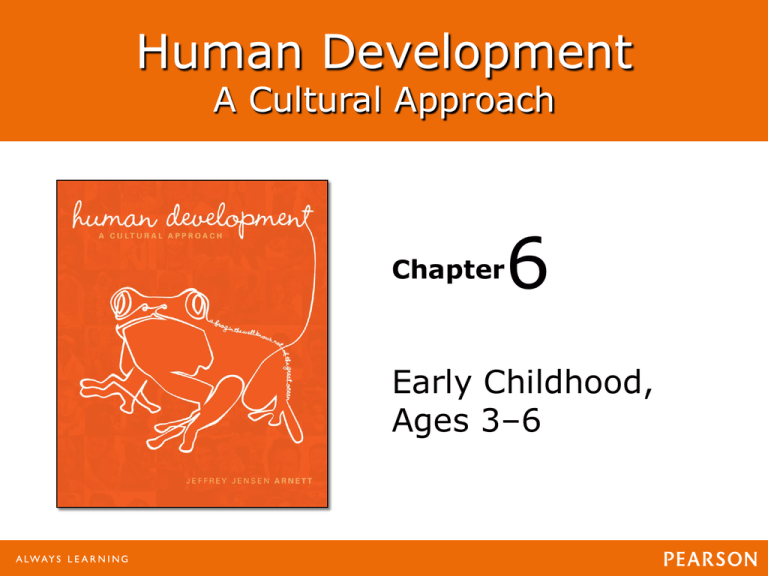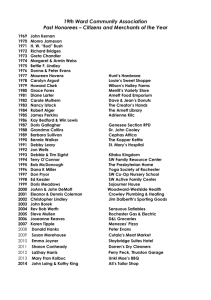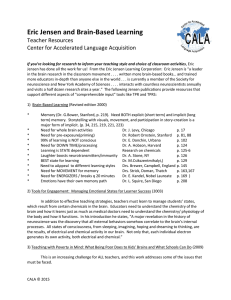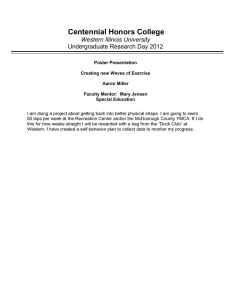6 Human Development A Cultural Approach Early Childhood,
advertisement

Human Development A Cultural Approach Chapter 6 Early Childhood, Ages 3–6 Human Development: A Cultural Approach Jeffrey Jensen Arnett Physical Development Human Development: A Cultural Approach Jeffrey Jensen Arnett Growth from Age 3 to 6: Body Growth • Children grow about 2–3 inches a year and add 5–7 pounds • Boys slightly taller and heavier than girls • Primary teeth replace primary baby teeth • Tooth decay varies by country Human Development: A Cultural Approach Jeffrey Jensen Arnett Growth from Age 3 to 6: Brain Development • Size of brain increases gradually during early childhood • Frontal lobe growth is important during preschool years • Four parts are extremely important Human Development: A Cultural Approach Jeffrey Jensen Arnett Growth from Age 3 to 6: Brain Development Human Development: A Cultural Approach Jeffrey Jensen Arnett Growth from Age 3 to 6: Health and Safety • Children are less vulnerable to health threats as in earlier years • Children in developing countries remain vulnerable to some illness and diseases Human Development: A Cultural Approach Jeffrey Jensen Arnett Map 6.1 Worldwide Mortality Rates and Causes of Death in Children Under Age 5 Which regions of the world have the lowest and highest rates of childhood deaths? How do the causes of death vary by region? Human Development: A Cultural Approach Jeffrey Jensen Arnett Growth from Age 3 to 6: Health and Safety • Slow physical growth corresponds with food consumption diminishing • Appetites vary day to day but environment drives food preference • This can drive unhealthy eating preferences Human Development: A Cultural Approach Jeffrey Jensen Arnett Growth from Age 3 to 6: Health and Safety • Developing countries face malnutrition as a norm • Lack of protein experienced by 25% of children Can lead to marasmus and kwashiorkor • Iron deficiency (anemia) is experienced by majority of children Causes fatigue, irritability, and difficulty sustaining attention Human Development: A Cultural Approach Jeffrey Jensen Arnett Growth from Age 3 to 6: Health and Safety • Developing countries causes of death are Illness, disease, malaria, measles, and pneumonia Malnutrition is responsible for half of early childhood deaths • Developed countries have vaccinations, adequate food, and medical care Human Development: A Cultural Approach Jeffrey Jensen Arnett Growth from Age 3 to 6: Health and Safety • Early childhood a time of high activity • High rates of injuries • Most common cause of injury are motor vehicle accidents • Higher injury rates in developing countries • Disease a larger problem than injuries Human Development: A Cultural Approach Jeffrey Jensen Arnett Motor Development: Gross and Fine Motor Skills • Gross motor skills extend abilities that appeared earlier Some gender differences • Fine motor development allows refinement of skills Drawing shapes, letters, and sentences Human Development: A Cultural Approach Jeffrey Jensen Arnett Motor Development: Gross and Fine Motor Skills Human Development: A Cultural Approach Jeffrey Jensen Arnett Motor Development: Handedness • Preferences for handedness can be seen prenatally • Genetics Adopted children resemble biological parents more than adoptive parents Identical twins likely to differ • Culture Historically left-handedness is considered evil Human Development: A Cultural Approach Jeffrey Jensen Arnett Cognitive Development Human Development: A Cultural Approach Jeffrey Jensen Arnett Piaget’s Preoperational Stage • Child begins to internalize images and use symbols • Inability to perform operations • Including Conservation Classification Egocentrism Animism Human Development: A Cultural Approach Jeffrey Jensen Arnett Conservation • Children lack the ability to understand conservation • This lack of understanding could be due to Centration—focusing on one aspect of a problem while excluding others Reversibility—reverse an action mentally Human Development: A Cultural Approach Jeffrey Jensen Arnett Figure 6.2 Various Substances Used in Piaget’s Conservation Task What cognitive limitations in young children lead to mistakes in these tasks? (continued on next slide) Human Development: A Cultural Approach Jeffrey Jensen Arnett Figure 6.2 Various Substances Used in Piaget’s Conservation Task What cognitive limitations in young children lead to mistakes in these tasks? (continued from previous slide) Human Development: A Cultural Approach Jeffrey Jensen Arnett Egocentrism/Classification • Egocentrism • An aspect of egocentrism is Animism • Classification Human Development: A Cultural Approach Jeffrey Jensen Arnett Egocentrism/Classification Human Development: A Cultural Approach Jeffrey Jensen Arnett Preoperational Substages • Piaget’s preoperational stage is divided into two stages Symbolic function substage—capable of representational thought and using symbols - Language and play can represent this stage Intuitive thought substage—capable of asking questions showing curiosity but not why they know things Human Development: A Cultural Approach Jeffrey Jensen Arnett Evaluating Piaget’s Theory • Criticisms of Piaget focuses on two main ideas Underestimated children’s abilities - Studies have shown young children can do conservation task - Can perform modified egocentrism task - Less animistic than Piaget suggested Development is more continuous and less stage like Human Development: A Cultural Approach Jeffrey Jensen Arnett Theory of Mind • The ability to understand the thinking processes in oneself and others • Seen in joint attention and pretend play • Identified by false belief task Human Development: A Cultural Approach Jeffrey Jensen Arnett Cultural Learning • Early childhood is when children have capacity for learning culturally specific skills • Can include food preparation, child care, and animal care • Developed countries may prepare grocery list, organize, count money, or hold conversations Human Development: A Cultural Approach Jeffrey Jensen Arnett Cultural Learning • Two factors impact differences in cultural learning Time apart from families in developed countries Complexity of adult activity in the economy Human Development: A Cultural Approach Jeffrey Jensen Arnett Early Childhood Education • Traditionally begins at age 7 • Consistently beginning earlier in developed countries • Developing countries slightly later but changing Human Development: A Cultural Approach Jeffrey Jensen Arnett Importance of Preschool Quality • Some effects include Higher verbal skills, stronger performance on memory, and listening comprehension Children from low income families who attend preschool score higher on school readiness Social children are more independent and confident Human Development: A Cultural Approach Jeffrey Jensen Arnett Importance of Preschool Quality • Quality of preschool has important role in outcomes Education and training of teachers Class size and child-teacher ratio Age appropriate materials and activities Teacher-child interactions • Focus for high quality is developmentally appropriate educational practice Human Development: A Cultural Approach Jeffrey Jensen Arnett Cross Cultural Variation • Japanese students score high in math, reading, and science in middle and high school • Early childhood education doesn’t focus on academics • Culture stresses group involvement and not academics Human Development: A Cultural Approach Jeffrey Jensen Arnett Preschool as a Cognitive Intervention • Early intervention programs focus on cognitive development especially for atrisk children Project Head Start—began in 1965 Can receive up to two years of preschool • Some debate the effectiveness of the program • Children less likely to repeat a grade or placed in special education Human Development: A Cultural Approach Jeffrey Jensen Arnett Preschool as a Cognitive Intervention • High Scope Preschool Project Full day, two year intervention program Similar IQ effects as Project Head Start but other long term effects Increased chance of graduating high school and attending college Less likely to become pregnant or arrested Increased income and family stability Human Development: A Cultural Approach Jeffrey Jensen Arnett Figure 6.4 Major Findings of the High Scope Preschool Study High Scope participants showed better academic performance, IQ scores, and earning potential and were less likely to be arrested later in life than other children. Source: Schweinhart et al., 2005 Human Development: A Cultural Approach Jeffrey Jensen Arnett Language Development • Language continues to progress at a rapid pace • There are cultural variations in fast mapping Eastern languages learn verbs first Western languages learn nouns first • Grammar continues to develop so that by age 4 about 90% of children use correct grammar Human Development: A Cultural Approach Jeffrey Jensen Arnett Figure 6.5 Berko’s Language Study How do the results of this study show young children’s grasp of grammar? Source: Adapted from Berko, 1958 Human Development: A Cultural Approach Jeffrey Jensen Arnett Pragmatics: Social and Cultural Rules of Language • Pragmatics refers to the social rules of language • Understanding begins through gestures • By age two some understanding of basic conversation • By age 4 more sensitive to partners in conversation Human Development: A Cultural Approach Jeffrey Jensen Arnett Emotional and Social Development Human Development: A Cultural Approach Jeffrey Jensen Arnett Emotional Regulation • Emotional self-regulation important for social relationships • Extreme emotional expressions decline with age • Effortful control allow children to focus attention on managing emotions Undercontrol Overcontrol Human Development: A Cultural Approach Jeffrey Jensen Arnett Moral Development • Sociomoral emotions develop due to awareness of expected behavior for the child’s culture • Empathy important for moral development Better at perspective taking Promotes prosocial behavior Human Development: A Cultural Approach Jeffrey Jensen Arnett Moral Development • Expectations of culture increases • Cultural similarities in when children grasp moral standards • Cultural differences in what is viewed as moral Human Development: A Cultural Approach Jeffrey Jensen Arnett Moral Development • Morality can be learned through custom complexes • Modeling is a variation of custom complexes found in American research • Children learn by watching others who are rewarded and punished for behaviors • Moral reasoning has some rudimentary beginnings in early childhood Human Development: A Cultural Approach Jeffrey Jensen Arnett Gender Development • Ages 3–4 gender identity intensifies • Ages 6–7 gender constancy is attained • Parents and peers play important role in gender socialization Fathers more insistent about gender roles Peers reinforce gender appropriate behaviors Human Development: A Cultural Approach Jeffrey Jensen Arnett Gender Development • Gender socialization leads to gender schemas Behaviors and activities categorized as male or female Tendency to confirm schemas and ignore inconsistency • Self-socialization is maintaining consistency between behavior and schemas Human Development: A Cultural Approach Jeffrey Jensen Arnett Parenting Styles and the Two Dimensions of Parenting Human Development: A Cultural Approach Jeffrey Jensen Arnett Outcomes Associated With Parenting Styles Human Development: A Cultural Approach Jeffrey Jensen Arnett Parenting • Cultural differences in traditional cultures Asian culture—filial piety Latino culture—Respeto/familismo • Cultures have different forms of warmth and control Human Development: A Cultural Approach Jeffrey Jensen Arnett Discipline and Punishment • Cultures differ on systems of discipline for misbehavior Western culture may emphasize authoritative approach including time out Japanese emphasizes withdrawal of love and shame • Culture influences consequences of discipline Human Development: A Cultural Approach Jeffrey Jensen Arnett Physical Punishment and Its Consequences • Physical punishment (corporal punishment) is common in most parts of the world • Many studies (western countries) have found detrimental effects of physical punishment Human Development: A Cultural Approach Jeffrey Jensen Arnett Physical Punishment and Its Consequences • U.S. research indicates differences between African American families and white families • Highlights the importance cultural context in children’s response to parent’s behavior Human Development: A Cultural Approach Jeffrey Jensen Arnett Child Abuse and Neglect • Physical abuse—physical harm • Emotional abuse—ridicule and humiliation • Sexual abuse—sexual contact • Neglect—do not meet basic needs of child Human Development: A Cultural Approach Jeffrey Jensen Arnett Child Abuse and Neglect • Children risk factors Difficult temperament Unusually aggressive • Parental risk factors Poverty Unemployment Single motherhood History of abuse (spousal included) • Assistance can come from foster care and group home Human Development: A Cultural Approach Jeffrey Jensen Arnett Sibling Relationship • Sibling relationships include Jealousy Ambivalence • Being an only child has shown mixed results Higher self esteem, social maturity, and intelligence Less successful social relationships (American) Human Development: A Cultural Approach Jeffrey Jensen Arnett Peers and Friends • Children are allotted more freedom to explore the social world from toddlerhood to early childhood • Tend to see increased gender segregation in early childhood Human Development: A Cultural Approach Jeffrey Jensen Arnett Peers and Friends • Cultural differences in age groups in early childhood peer groups • Children in West tend to be same age, in developing countries tends to be mixed age groups Human Development: A Cultural Approach Jeffrey Jensen Arnett Play in Early Childhood • Solitary and parallel play decline while cooperative and social play begin to increase • Increased sex segregation in play • Increased experience in preschool can lead to increased success in social play Human Development: A Cultural Approach Jeffrey Jensen Arnett Figure 6.6 Play in Four Cultures Across cultures, play is the most common activity in early childhood. Source: Based on Tudge et al. (2006) Human Development: A Cultural Approach Jeffrey Jensen Arnett Aggression • • • • • Instrumental aggression Hostile aggression Relational aggression Physical aggression tends to decline Verbal and relational aggression tend to increase Human Development: A Cultural Approach Jeffrey Jensen Arnett Media in Early Childhood • Children watch 1.5–3 hours of television a day • Effects include increased aggressive behavior and susceptibility to advertising • Positive effects include higher language and math skills Human Development: A Cultural Approach Jeffrey Jensen Arnett Media in Early Childhood • Electronic gaming is increasing with boys playing more than girls • More research on music may need to be done Human Development: A Cultural Approach Jeffrey Jensen Arnett




